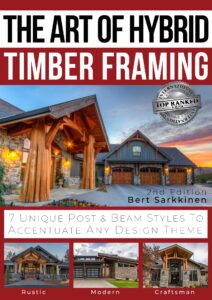The 19 best books on construction and architecture in wood
This list of fantastic books aims to satisfy the curiosity of the most sustainable architects. We have made available thousands of pages full of designs, ideas, techniques, images and inspiration with one common denominator: a love for wood.
It’s a fact: wood is ever more present in our buildings and infrastructure. In reality, it has always been there, as its role as a building material began alongside architecture itself. Nevertheless, today it is experiencing a fascinating rebirth, fostered by an ever more sustainable concept of life and the increase in its structural possibilities thanks to technology.
To bring you up to date we have drawn up this selection of books on architecture and construction using wood, where you will find research, ideas and designs made reality. We have combined recent publications, which tell us about innovative ways to get closer to design and construction using wood, with a good handful of classic books that cannot be left off the bookshelves of architects, engineers and builders who exercise their profession with a commitment to respecting the environment.
1. 100 Contemporary Wood Buildings
Exquisite Taschen edition in which the author Philip Jodidio sets out a good number of construction works built with wood at centre stage. These spectacular images are complemented with the profiles of classic architects who have already used wood in large projects, such as Renzo Piano, as well as some young professionals who choose wood for their projects.

More information on the book
2. Manual of Multi Storey Timber Construction
An update of one of the great publications that the journal Detail brings us from time to time. In this work, the authors Hermann Kaufmann, Stefan Krötsch and Stefan Winter focus on the possibilities of wood in the construction of buildings with several floors in an urban setting.
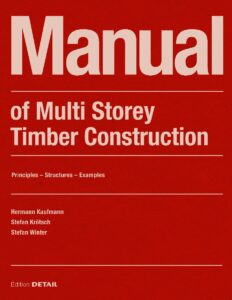
More information on the book
3. Timber Buildings S, M, L
It shares 30 construction works built with different types and uses of wood: mountain refuges, schools, public works, etc. One interesting aspect is that the author, Sandra Hofmeister, provides construction designs and drawings. Also edited by Detail.
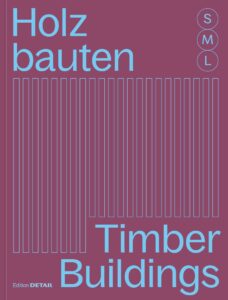
More information on the book
4. The Art of Hybrid Timber Framing
Bert Sarkkinen, the author of this book, is a master of hybrid structures with wood. Nevertheless he states that this work is not a technical manual. He aims to help prevent aesthetic errors by considering the real possibilities of projects, showing us the various existing styles and advising us to stress the investment necessary depending on the objectives. Practical and interesting.
More information on the book
5. Building with Hardwood
In this publication by Detail, the authors Konrad Merz, Anne Niemann and Stefan Torno share technical knowledge for the safe handling of hardwood in building construction. They combine their teaching with images of successful cases of this type of architecture.
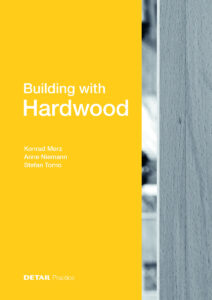
More information on the book
6. Tall Wood Buildings
It seems that the studies, theses and publications related to tall wooden buildings aim to demonstrate that there nothing is impossible for wood… if you know how to do it, of course. In this book, Michael Green and Jim Taggart share the different construction types of tall buildings with wood and illustrate them with 13 real cases.
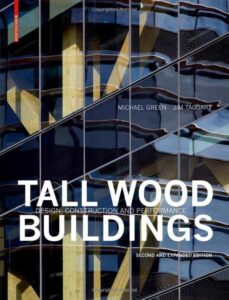
More information on the book
7. Out of the Woods
With the subtitle of Architecture and Interiors Built from Wood, Rosie Flanagan and Steph Wade extol wood as the smart, sustainable alternative to concrete. The authors show the versatility of this material including an illustrated glossary of new uses and structures, and share creative constructions of all types made of wood.
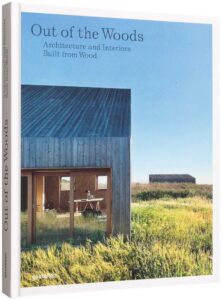
More information on the book
8. Timber Structures in Vorarlberg
Vorarlberg, a province in Austria, is a world leader in the quality of architectural design and construction in wood. It is no surprise that the journal of architecture Detail has decided to launch a publication compiling all the buildings found there. A truly stimulating book for architects wishing to get the most out of their use of wood. The authors are Florian Aicher and Renate Breuss.
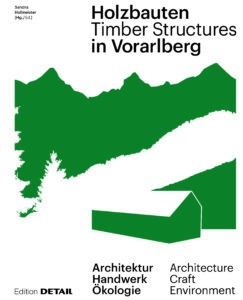
More information on the book
9. Wood
After his previous Concrete (2012) and Brick (2015), William Hall brings his trilogy of key construction materials in modern architecture to a close with Wood. This book covers a thousand years of architecture and construction with wood, compiling designs that go from treehouses or Tudor-style mansions to today’s emblematic projects, such as the Jean-Marie Tjibaou Cultural Centre by Renzo Piano.
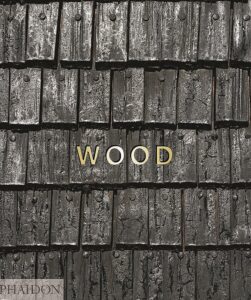
More information on the book
10. Advancing Wood Architecture: A Computational Approach
An interesting vision by Achim Menges, Tobias Schwinn and Oliver David Krieg. Written in 2016, the authors cover the new architectural possibilities of wood thanks to technological progress in design, simulation, digital manufacture and construction. It includes projects by leading design research groups in Europe.
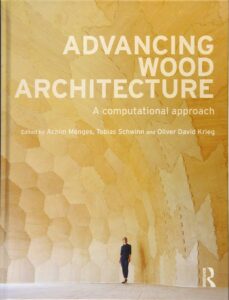
More information on the book
11. Architecture in Wood
Will Pryce, one of the most highly regarded architecture photographers in Great Britain, goes all around the world using his camera to capture not only the shape and design, but also the emotion within in a good number of different wooden structures. A wonder to see.
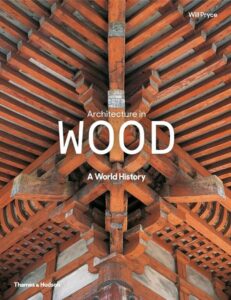
More information on the book
12. Learn to Timber Frame
In this self-styled “first guide to wooden structures for beginners”, Will Beemer explains, step by step, how to build yourself a wood cabin. The process starts with the supply of wood and ends by showing how to add modules to the cabin… so that in the end you can build a whole house yourself. For those who love a challenge and practical teaching.
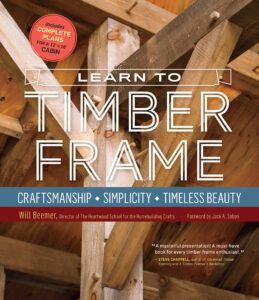
More information on the book
13. Solid Wood
In this work Joseph Mayo shares practical cases of architecture, technology and design with solid wood. The author places this material as a direct rival to concrete and makes his argument with international projects in United Kingdom, Norway, Sweden, Germany, Austria, Italy, Canada, United States, New Zealand and Australia.
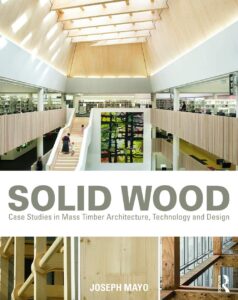
More information on the book
14. Detail in Contemporary Timber Architecture
The secret is in the details. That is the thesis that Virginia McLeod develops through 50 projects designed in wood. Each one of the examples is illustrated with complete specifications including colour images, drawings, names of clients, subcontractors, etc. Ideal for architecture student who want know all the details —and never better said— of the gestation of a project, in this case wood.
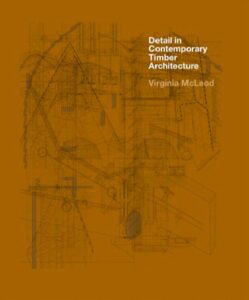
More information on the book
15. Wood: Architecture & Design
A review of contemporary architecture in wood where Michelle Galindo highlights the innovations in building techniques that, according to the author, are the true key to the development of wood-based architecture and construction.
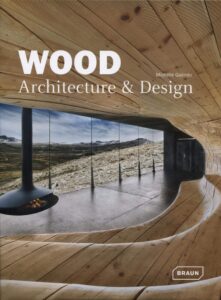
More information on the book
16. A Timber Framer’s Workshop
This classic manual by Steve Chappell was first edited in 1983. Since then, the joinery, design and construction of wooden structures, including the material itself, have taken a giant leap thanks to technology. Therefore this revised edition updates all the information, so that beginners, students, architects, engineers and contractors can gain in-depth insights into the secrets of the construction of wooden structures.
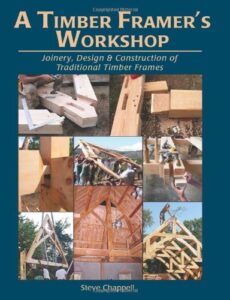
More information on the book
17. The New Timber-Frame Home
Like the previous book, this guide by Tedd Benson provides practical advice on the construction of wooden homes. An interesting point is that the author also focusses on advising owners on how to interact with designers, subcontractors, etc. during the project.
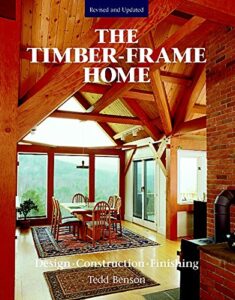
More information on the book
18. Timber Frame Construction
Another “do-it-yourself”. This book by Jack Sobon and Roger Schroeder has the charm of having been written a thousand years ago. Or almost. It was first edited in 1984, so reading it can help architecture and construction professionals to know where wood-based construction was four decades ago and where it is now. It is always enriching to know how the sector and our profession have evolved.
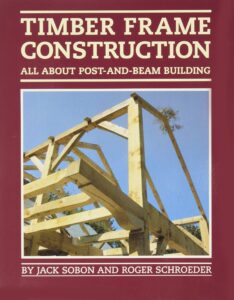
More information on the book
19. Facade Construction Manual
We conclude this selection with another manual from Detail that, although it does not centre on a single material, it does dedicate space to façades constructed with wood. It couldn’t be any other way, as the authors Thomas Herzog, Roland Krippner and Werner Lang highlight the façade as a vital milestone of architectural design, as it is the structure that lays the foundations for a good part of a building’s sustainability and efficiency targets. Similarly, the façade is the “face” and outer personality of a building, what links it to its environment.
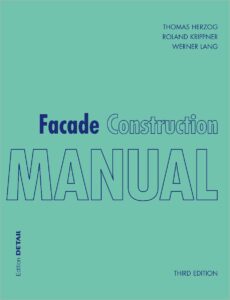
More information on the book
To fulfil these sustainability, efficiency and aesthetic goals, wood has in recent times become an unbeatable material thanks to innovation. For example, technology has helped glulam wood achieve structural properties that were unthinkable a few years ago.
For example, it is already possible to manufacture structural beams of any size, even curved beams. The latest innovation in this regard is oak glulam, an exquisite, elegant wood that is starting to conquer façades, interiors and ceilings throughout Europe.
This structural advantage facilitates the construction of lightweight façades made with wooden curtain walling, a solution that gives buildings and cities warmth and sustainability. In this article you can see examples of real projects of oak curtain walling.


